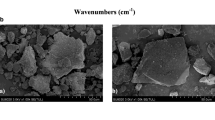Abstract
A molecularly imprinted polymer prepared using 1-allylpiperazine (1-ALPP) as the functional monomer, trimethyltrimethacrylate (TRIM) as the crosslinker and the zearalenone (ZON)-mimicking template cyclododecanyl-2,4-dihydroxybenzoate (CDHB) has been applied to the clean-up and preconcentration of this mycotoxin (zearalenone) and a related metabolite, α-zearalenol (α-ZOL), from cereal and swine feed sample extracts. The extraction of ZON and α-ZOL from the food samples was accomplished using pressurized liquid extraction (PLE) with MeOH/ACN (50:50, v/v) as the extraction solvent, at 50 °C and 1500 psi. The extracted samples were cleaned up and preconcentrated through the MIP cartridge and analyzed using HPLC with fluorescence detection (λ exc=271/ λ em=452 nm). The stationary phase was a polar endcapped C18 column, and ACN/MeOH/water 10/55/35 (v/v/v, 15 mM ammonium acetate) at a flow rate of 1.0 mL min−1 was used as the mobile phase. The method was applied to the analysis of ZON and α-ZOL in wheat, corn, barley, rye, rice and swine feed samples fortified with 50, 100 and 400 ng g−1 of both mycotoxins, and it gave recoveries of between 85 and 97% (RSD 2.1–6.7%, n=3) and 87–97% (RSD 2.3–5.6%, n=3) for α-ZOL and ZON, respectively. The method was validated using a corn reference material for ZON.


Similar content being viewed by others
References
Abdulkadar AHW, Al-Ali AA, Al-Kildi AM, Al-Jedah JH (2004) Food Control 15:543–548
Betina V (1989) Bioactive molecules. Mycotoxins. Elsevier, Amsterdam 9:271
Richardson KE, Hagler WM, Mirocha CJ (1985) J Agric Food Chem 33:862–866
Liu MT, Ram BP, Hart LP, Pestka JJ (1985) Appl Environ Microbiol 50:332–336
Diekman MA, Green ML (1992) J Anim Sci 70:1615–1627
De Saeger S, Sibanda L, Van Peteghem C (2003) Anal Chim Acta 487:137–143
Minervini F, Dell’Aquila M E, Maritato F, Minoia P, Visconti A (2001) Toxicol In Vitro 15:489–495
Krska R, Josephs R (2001) Fresenius J Anal Chem 369:469–476
Kruger SC, Kohn B, Ramsey CS, Prioli R (1999) J AOAC Int 82:1364–1368
Visconti A, Pascale M (1998) J Chromatogr A 815:133–140
EC (2005) Commission Regulation (EC) No 856/2005 amending Regulation (EC) No 466/2001 as regards Fusarium toxins. European Communities, Brussels
EC (2005) Commission Directive 2005/38/EC, laying down the sampling methods and the methods of analysis for the official control of the levels of Fusarium toxins in foodstuffs. European Communities, Brussels
Swanson SP, Corley RA, White DG, Buck WB (1984) J Assoc Off Ana Chem 67:580–582
Tanaka T, Yoneda A, Inoue S, Sugiura Y, Ueno Y (2000) J Chromatogr A 882:23–28
Silva CMG, Vargas EA (2001) Food Addit Contam 18:39–45
Radová Z, Hajslová J, Králová J, Papousková L, Sýkorová S (2001) Cereal Res Commun 29:435–442
Rhyn P, Zoller O (2003) Eur Food Res Technol 216:319–322
Mateo JJ, Mateo R, Hinojo MJ, Llorens A, Jiménez M (2002) J Chromatogr A 955:245–256
Pallaroni L, von Holst Ch (2003) J Chromatogr A 993:39–45
Jodlbauer J, Zöllner P, Lindner W (2000) Chromatographia 51:681–687
Zöllner P, Berner D, Jodlbauer J, Linder W (2000) J Chromatogr B 738(2):233–241
Abouzied MM, Pestka JJ (1994) J AOAC Int 77:495–501
Lee MG, Yuan QP, Harlt LP, Pestka JJ (2001) In: Trucksess MW, Pohland AE (eds) Methods in molecular biology. Humana, Totowa, NJ, p 159
Urraca JL, Benito-Peña E, Pérez-Conde C, Pestka JJ, Moreno-Bondi MC (2005) J Agric Food Chem 53:3338–3344
AOAC (1998) Official methods of analysis, 16th edn. Method 985.18. Association of Official Analytical Chemists, Gaithersburg, MD
Pallaroni L, von Holst Ch (2003) Anal Bioanal Chem 376:908–912
Pallaroni L, von Holst Ch (2004) J Chromatogr A 1055:247–249
Urraca JL, Marazuela MD, Moreno-Bondi MC (2004) Anal Chim Acta 524:175–183
Schuhmacher R, Krska R, Grasserbauer M, Edinger W, Lew H (1998) Fresenius J Anal Chem 360:241–245
Llorens A, Mateo R, Mateo JJ, Jiménez M (2002) Food Addit Contam 19:272–281
Ensing K, Berggren Ch, Majors RE (2002) LC GC Eur January, pp 2–8
Kandimalla VB, Hunagxian J (2004) Anal Bioanal Chem 380:587–605
Mayes AG, Whitcombe MJ (2005) Adv Drug Deliv Rev 57(12):1742–1778
Haupt K (2003) Anal Chem 17:377A–383A
Weiss R, Freudenchuss M, Krska R, Mizaikoff B (2003) Food Addit Contam 20:386
Krska R, Welzig E, Berthiller F, Molinelli A (2005) Food Addit Contam 22:345–353
Josephs R, Krska R (2000) Mycotox Res 16A:217–220
Acknowledgements
This work has been funded by the Spanish Ministry of Education and Science (Project No. BQU2002-04515-C02). MDM and JUP thank to the Spanish Ministry of Science and Technology for a Ramón y Cajal contract and a pre-doctoral grant, respectively. The authors gratefully acknowledge E. Merino and Prof. Orellana for CHDB synthesis and Dr. Krska from the Institute for Agrobiotechnology (IFA-Tulln, Austria) for providing the corn reference material for validation purposes.
Author information
Authors and Affiliations
Corresponding author
Rights and permissions
About this article
Cite this article
Urraca, J.L., Marazuela, M.D. & Moreno-Bondi, M.C. Molecularly imprinted polymers applied to the clean-up of zearalenone and α-zearalenol from cereal and swine feed sample extracts. Anal Bioanal Chem 385, 1155–1161 (2006). https://doi.org/10.1007/s00216-006-0343-3
Received:
Revised:
Accepted:
Published:
Issue Date:
DOI: https://doi.org/10.1007/s00216-006-0343-3




